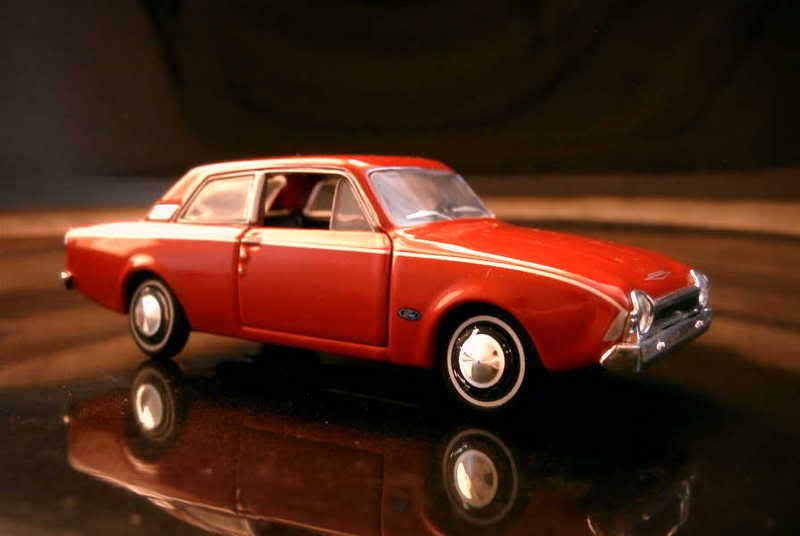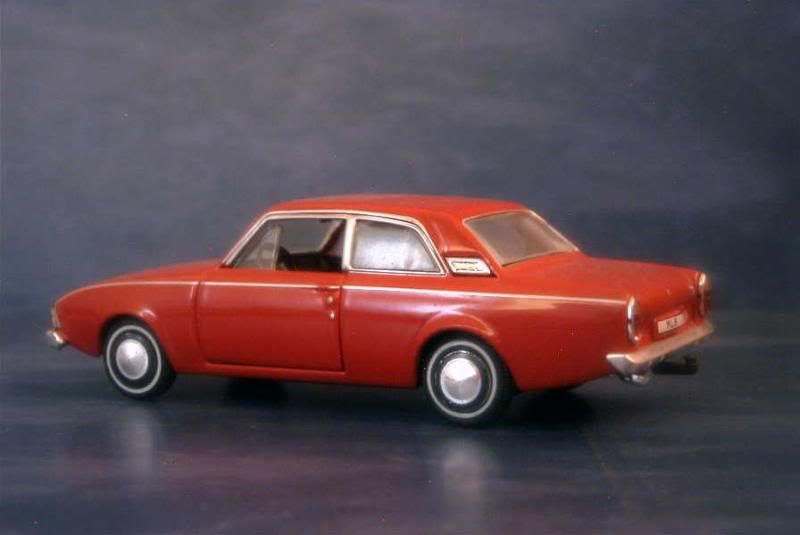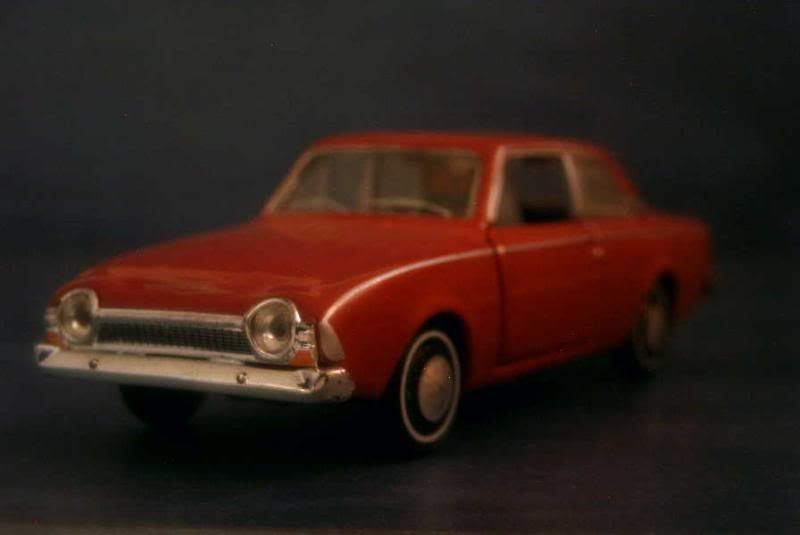A little history
The Corsair appeared in October 1963 during the London motor show as a member of the large Consul family of mid-range cars that was then offered by the British branch of the American giant, Ford. The new car’s appearance surprised the visitors at Earl’s Court: the recently-released Ford Thunderbird’s front end had been transposed without much modification beyond the replacement of quad headlights by single units. Though the T-Bird’s styling was praised, it could seem ungainly to some when applied to the Corsair but, at any rate, the British car looked bold for the era.
The Corsair was certainly not as daring from a mechanical point of view. Conventional throughout – British cars have rarely been innovative, all the more in those times – it received the very same 1.5-litre inline four that already powered the Cortina. With only 60 bhp, the first Corsairs, offered either as 2-door or 4-door saloons, were noticeably deficient in terms of performance. Another annoying detail was the tiny size of the gasoline tank: with only 35 litres, carefully planning a long trip was a necessity in order to avoid strolling around the countryside, an empty can in one hand.
The Corsair had many flaws, but it certainly had qualities. My father reported to me once that a friend of him bought this brand-new Ford during the Sixties, and was proud to demonstrate how tough the gearbox was by switching from fourth to first at about 100+ kph. Despite this harsh treatment, you didn’t have to get out of the car as soon as it stopped and walk back a few hundred metres in order to gather transmission parts on the pavement… Another incredible trait, that was common to all British-built Fords of the time, was the thickness of the metal sheets stamped into body parts. This certainly didn’t make these cars light, but at least they were as tough as a Churchill tank.
Ford knew well its Corsair didn’t benefit from the engine it deserved, and as soon as 1965 discontinued the 1.5-litre version in favour of a new car fitted with the new V4 block. To this 1.7-litre unit a 2.0-litre was added in 1966, but unfortunately improvements were marginal while both these engines had the mellow of a pneumatic drill when driven at any pace.
The Corsair was produced until 1970, when it departed Ford’s range without too much regret. The third-generation Cortina succeeded both this car and the previous Cortina. A little more than 300,000 Corsairs had been built, the majority of them sold on the domestic market – despite my father’s friend story, they were extremely rare in most continental countries.
About the model
Model: Ford Corsair
Year: c.1963
Maker: Hongwell
Scale: 1/43
Distributed by: Cararama
Acquired: second hand with neither stand nor box, in January 2007, in Shenzhen, China
By somewhat sacrificing quality in order to keep its prices down, Cararama is able to appeal to both adults seeking a collectible item and children playing with it as a toy, the latter, thanks to their innate wisdom, being less sensible to the car reproduced than we collectors are, always looking for the same models over and over while neglecting more original vehicles. This again seems to prove that it is perfectly possibly feasible and profitable to mass-produce a die-cast of a not-so-famous automobile, whatever some may say about this.
Actually this model’s quality is far from mediocre. Simple should be the aptest word to describe it, but it looks good. Opening doors, a detail I usually dislike for their unrealistic character, are adjusted well enough to make themselves discreet. As a result, I grabbed this model as soon as I found it, and now give it an honourable 12/20.



The Corsair appeared in October 1963 during the London motor show as a member of the large Consul family of mid-range cars that was then offered by the British branch of the American giant, Ford. The new car’s appearance surprised the visitors at Earl’s Court: the recently-released Ford Thunderbird’s front end had been transposed without much modification beyond the replacement of quad headlights by single units. Though the T-Bird’s styling was praised, it could seem ungainly to some when applied to the Corsair but, at any rate, the British car looked bold for the era.
The Corsair was certainly not as daring from a mechanical point of view. Conventional throughout – British cars have rarely been innovative, all the more in those times – it received the very same 1.5-litre inline four that already powered the Cortina. With only 60 bhp, the first Corsairs, offered either as 2-door or 4-door saloons, were noticeably deficient in terms of performance. Another annoying detail was the tiny size of the gasoline tank: with only 35 litres, carefully planning a long trip was a necessity in order to avoid strolling around the countryside, an empty can in one hand.
The Corsair had many flaws, but it certainly had qualities. My father reported to me once that a friend of him bought this brand-new Ford during the Sixties, and was proud to demonstrate how tough the gearbox was by switching from fourth to first at about 100+ kph. Despite this harsh treatment, you didn’t have to get out of the car as soon as it stopped and walk back a few hundred metres in order to gather transmission parts on the pavement… Another incredible trait, that was common to all British-built Fords of the time, was the thickness of the metal sheets stamped into body parts. This certainly didn’t make these cars light, but at least they were as tough as a Churchill tank.
Ford knew well its Corsair didn’t benefit from the engine it deserved, and as soon as 1965 discontinued the 1.5-litre version in favour of a new car fitted with the new V4 block. To this 1.7-litre unit a 2.0-litre was added in 1966, but unfortunately improvements were marginal while both these engines had the mellow of a pneumatic drill when driven at any pace.
The Corsair was produced until 1970, when it departed Ford’s range without too much regret. The third-generation Cortina succeeded both this car and the previous Cortina. A little more than 300,000 Corsairs had been built, the majority of them sold on the domestic market – despite my father’s friend story, they were extremely rare in most continental countries.
About the model
Model: Ford Corsair
Year: c.1963
Maker: Hongwell
Scale: 1/43
Distributed by: Cararama
Acquired: second hand with neither stand nor box, in January 2007, in Shenzhen, China
By somewhat sacrificing quality in order to keep its prices down, Cararama is able to appeal to both adults seeking a collectible item and children playing with it as a toy, the latter, thanks to their innate wisdom, being less sensible to the car reproduced than we collectors are, always looking for the same models over and over while neglecting more original vehicles. This again seems to prove that it is perfectly possibly feasible and profitable to mass-produce a die-cast of a not-so-famous automobile, whatever some may say about this.
Actually this model’s quality is far from mediocre. Simple should be the aptest word to describe it, but it looks good. Opening doors, a detail I usually dislike for their unrealistic character, are adjusted well enough to make themselves discreet. As a result, I grabbed this model as soon as I found it, and now give it an honourable 12/20.






4 comments:
Yes, this a rarity. I think the Corsair is one of the less known Ford's. But is very interesting. (sorry about my english)
No problem at all with your English, José António. Personally I agree with you, as I rarely saw an picture of this car or read anything about it. No need to mention that I never saw any for real...
I think i've got a book about Ford's Performance cars that talk about this model... i'll confirm this tomorrow...
"Ford's performance cars"... that seems a little optimistic about the Corsair! Well, will wait for your next post. ;)
Post a Comment